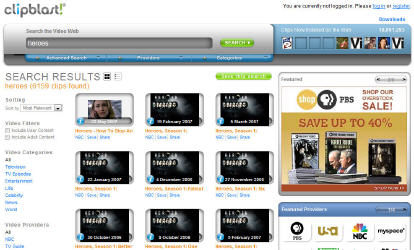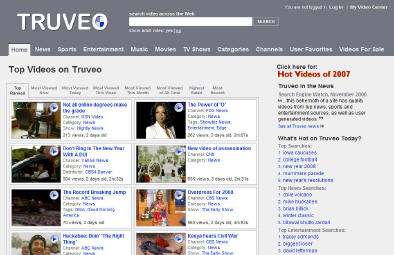-
Insights Aplenty from How-to Video Category
One of the hottest corners of the broadband video market is the ad-supported "how-to" category. How-to lends itself well to video because, if a picture's worth a thousand words, a video is surely worth a million. Recognizing this, there's now a host of start-ups in this category which together have raised tens of millions of dollars. I wrote about some of this a couple months ago.
Several recent calls with industry participants got me to thinking the how-to category actually offers many valuable insights for all broadband industry participants. These fall into 3 key areas: content development, traffic acquisition and monetization.
1. Content: "Build Our Own" or "Offer a Superstore of Others' Videos"?
Players like Expert Village, 5Min, VideoJug and MonkeySee are pursuing the "build our own" video library approach, incenting individual "experts" to contribute to their sites. On the other hand, sites like WonderHowTo (WHT) and SuTree rely primarily on scouring user-generated video sites like YouTube, plus those above to aggregate the best videos available. With how-to being the ultimate "Long Tail" space,
 WHT's Stephen Chao told me in a recent briefing that trying to cover the infinite number of niches would be impossible. So to be comprehensive, relevant and high-quality, WHT curates what its crawlers return with a small in-house team and presents the cream of the crop to users, complete with a range of community-building features.
WHT's Stephen Chao told me in a recent briefing that trying to cover the infinite number of niches would be impossible. So to be comprehensive, relevant and high-quality, WHT curates what its crawlers return with a small in-house team and presents the cream of the crop to users, complete with a range of community-building features. Here's one non-statistically significant example that illustrates the two approach's results: I did a search for "bbq steak video" on Expert Village, which bills itself as the "World's Largest How-to Video Site" and on WHT. EV returned 15 results, regrettably not one of which was relevant. WHT returned 357 results, and on the first page of 20 results alone, at least 12 looked relevant. These came from a wide variety of sources. Try doing a few searches and see what you find - my guess is your experience will be consistent with mine.
2. Traffic acquistion: Syndication or SEO?
All of these sites are ad-supported, so traffic is key. The sites with private libraries can syndicate to heavily-trafficked partners. Ordinarily, as a big syndication fan, I'd say that sounds like an advantageous traffic generating plan. But how-to may have a different traffic acquisition dynamic. It may well be that far more traffic will always come to these how-to video sites via searches at Google and other search sites, as compared with the sum of various syndication deals. That's because, absent a household brand-name in how-to, default consumer behavior may well be to simply type their how-to video query into Google.
If that's the case, then it will actually be those sites which have the most highly-optimized pages for all the
 niche videos that will gain greater traffic. Though I'm not an SEO expert, it seems to me that, taking my "bbq steak videos" example, WHT, with 357 related videos can optimize better than say EV with 15. And sure enough, when I ran the "bbq steak video" search on Google, right on the first page is a result from WHT, whereas nothing shows up for EV even after 5 pages. Bottom line: more relevant videos = more zero cost, Google-driven traffic.
niche videos that will gain greater traffic. Though I'm not an SEO expert, it seems to me that, taking my "bbq steak videos" example, WHT, with 357 related videos can optimize better than say EV with 15. And sure enough, when I ran the "bbq steak video" search on Google, right on the first page is a result from WHT, whereas nothing shows up for EV even after 5 pages. Bottom line: more relevant videos = more zero cost, Google-driven traffic. 3. Monetization: Video ads or Keyword-driven text/display ads?
Last but not least is monetization. How-to sites have lots of contextual ad potential. In my "bbq steak" example, any company that sells grills, steaks, sauces, etc, would love to advertise to me. It's tempting to believe that those with their own video libraries have more profit potential, because they can sell pre-roll or overlay ads, whereas a superstore site like WHT or SuTree cannot, because they're linking off to the source sites.
But consider this: how many of these potential advertisers will actually have video ads or the budget to create them? Unlike entertainment video, how-to, with its Long Tail character, seems to lend itself more to a low cost keyword ad approach which can be pursued by even the smallest advertiser. So say WHT or SuTree can build traffic in all those video niches and surround the video with keyword-driven text or display ads, all automated through a bidding system. Though yielding lower revenue per ad, my bet is that the total revenue for all ads with the keyword approach would be greater.
Summary
The how-to category is nascent and dynamic. I'm not suggesting for a second that it's a winner-take-all space or that all of the above are strictly "either/or." But I do believe the above analysis raises valuable points all industry participants should consider when developing their content, traffic and monetization strategies.
What do you think? Post a comment now!
Categories: Advertising, Indie Video, Startups, Strategy, Video Search
Topics: 5Min, Expert Village, MonkeySee, SuTree, VideoJug, WonderHowTo, YouTube
-
Modern Feed Jumps Into Video Navigation Space
With the proliferation of available broadband video comes a massive user navigation challenge. Modern Feed is launching today to address this. It is part search engine, part aggregator, with a specific focus on indexing professionally-produced programming, not user-generated video. It's also focused on actual programs, not promotional clips.
J.D. Heilprin, Modern Feed's founder/CEO told me yesterday that the company is targeting mainstream users providing the easiest way to find available, high-quality video. It employs a team of "Feeders" charged with curating the best videos to include on the site. The result is approximately 550 "networks" and 25,000 pieces of content now indexed, where "networks" is a loose term ranging from traditional broadcasters to indies new entrants like Boston Symphony or Architectural Digest.
Modern Feed is rights-holder friendly, not indexing any illegal or pirated video, and playing the video from the source's site (though sometimes with a thin Modern Feed navigation frame at the top of the screen). I played around with Modern Feed and found it to be easy-to-use and well-laid out. Modern Feed also offers an iPhone implementation that looks pretty cool, other devices are to follow.
The big challenge (and opportunity) for Modern Feed is that it's entering a very noisy space where user behavior is very undefined. There are myriad video search engines (Truveo, ClipBlast, blinkx, Veveo), portals (AOL, Yahoo, MSN), navigation sites (TV Guide, recently-launched PrimeTime Rewind) and of course the networks' own sites (and syndication efforts) offering users the ability to quickly find quality content. Then there's YouTube, the first stop for many users when it comes to video. And YouTube is increasingly moving up market by striking partnerships with premium providers.
Modern Feed's strong user experience, focus on mainstream users and device integrations are differentiators for the company. Whether these are ultimately success factors really depends on how user behavior unfolds in the nascent video navigation space. Modern Feed has raised several million dollars from angels and has 30 full-timers with aggressive growth planned.
What do you think? Post a comment and let everyone know!
See prior posts:
YouTube, C-SPAN Team Up for User-Generated, Multi-Platform Voter Project
Categories: Startups, Video Search
Topics: AOL, Blinkx, ClipBlast, Modern Feed, MSN, PrimeTime Rewind, Truveo, TV Guide, Yahoo, YouTube
-
EveryZing: Video Search Meets SEO
As some of you may suspect by now, I've become a little obsessed with understanding the nascent video search space. It's a source of continued fascination for me that there are so many smart people with so many different technology and business strategies pursuing this area. Google's success in web search is surely influencing the massive interest in reaching for the brass ring of video search.
The latest to hit my screen is EveryZing, which is announcing today two new products, ezSEO (Search Engine Optimization) and ezSearch. These two products combine to increase exposure/discoverability of broadband video content (plus, text, audio and images) and drive more monetization opportunities. New customers announced today include boston.com, Dow Jones, Reuters and Entercom. I caught up with CEO Tom Wilde yesterday to learn more.

EveryZing isn't a consumer destination site a la Truveo or blinkx. Instead, it's a pure white-label technology ASP for content providers. It uses proprietary speech-to-text technology to create meaningful text-based descriptions of video and other assets. As Tom says, because "text is the navigation currency of the web" it is essential that video assets be characterized this way for them to be fully discoverable. EveryZing takes a holistic view of search, allowing its content providers to also use its technology for HTML documents and other assets if they choose to. Either way, EveryZing enables universal search across media types. All of this is the role of role of ezSearch.
But EveryZing realizes that just making video more discoverable within web sites doesn't drive a lot of new revenue for content companies. Instead these videos (and other assets) must be packaged and presented in an SEO-friendly way to drive maximum traffic from the search economy (aka Google). More traffic means more ad inventory to monetize. In short, ezSEO addresses the most vexing issue facing all video providers - how to actually make money in broadband video? EveryZing achieves SEO by pouring the results of ezSearch into its publishing system, which in turn creates search-friendly multimedia topic pages that are SEO-friendly. See example below:

EveryZing's focus on creating these search-friendly topic pages reflects a tried and true tactic in SEO. For example, just last week at the FAST Forward '08 conference, the NYTimes.com shared how it does exactly the same thing for 16,000+ topics. (For example, type "Global Warming" into Google and the 8th result will be the NYTimes.com topic page). The pursuit of these kinds of SEO techniques has spawned an entire cottage industry for helping web publishers get their content noticed and monetized.
EveryZing is taking a page from this playbook and applying it to broadband video. It seems like a very sound and logical approach, which is showing a lot of early promise. Tom shared statistics for boston.com. Since it implemented EveryZing's technology last fall, the number of page views for its SEO-friendly pages has increased 37-fold, and the number of videos streamed from these pages 172-fold. Of course all those new video streams yield monetizable ad inventory, but it's important to remember that the SEO pages themselves also yield lots of valuable, context-rich ad inventory for display ads.
When you combine the huge enthusiasm around SEO and video, an obvious question is "why hasn't anyone done this already?" Tom's answer is instructive for all entrepreneurs, and goes to the heart of what increases the odds of success for early-stage companies: it takes a very unique combination of distinctive technology, executives' deep domain expertise, proper market timing, specific strategy/focus and respect for customers' finite resources. I completely agree with his assessment, particularly the importance of executives' domain expertise which I've observed really helps in unearthing subtle market opportunities. EveryZing seems to have all of the above which makes it a company well-worth watching. It has 40 employees and has raised $13.5M to date.
Categories: Startups, Video Search
Topics: EveryZing
-
Veveo: More Innovation in Video Search
Innovation in video search continues apace. A new entrant is Veveo, which, upon my first review, looks poised to raise the bar of innovation in this still-evolving space. I spent a couple of hours with CEO/co-founder Murali Aravamudan to learn more about their approach.
I continue to be fascinated with video search and have previously written about current players such as Truveo, blinkx, ClipBlast, Nexidia and TV Guide. I believe video search is the most intellectually challenging part of the broadband video value chain as well as the one with the greatest potential upside for those who ultimately crack this highly complex nut. Video search presents many of the same issues as web search, but layers on additional challenges around relevancy, metadata, user navigation and monetization. Because of the explosion of video choices, users will increasingly rely on video search providers who can expedite retrieval of desired results.
Veveo approaches the key problem of relevancy by trying to emulate some of what's behind Google's vaunted PageRank. As many of you know, PageRank prioritizes relevancy by relying heavily on the number of referring links to a given page. To try to proxy this referral process in the nascent video world, Veveo has developed its algorithms to account for # of people subscribing to a video channel (at say YouTube), user ratings, viewcount, session length and other factors.
Returning relevant results requires a complete index of available video, which has led Veveo to index approximately 125M videos currently. Murali believes is on a par with the established players. The index spans professional video to UGC and short clips to full-length programs.
Though Murali obviously wasn't going to provide too much detail on Veveo's algorithms (not that I'd understand them anyway), their capabilities are on display when running queries at Veveo's beta site located here. Veveo does something I haven't seen elsewhere - notice as you slowly type your query, the search box not only begins autofilling, but new results are also dynamically served up. Even at Google, while the search box will autofill based on Google's anticipation of your intended query, no results are shown until you're done and click enter. For Veveo to be able to do this means its algorithms are both anticipating your query AND simultaneously matching them against its index. Because there are so many videos, Veveo has had to organize them semantically to accelerate the matching process. And don't forget: because there's no client download, the retrieval process is all happening virtually in real time. Admittedly, this process is not being done at scale yet, but Murali is confident that it will perform similarly even when there are millions of concurrent users.
To see what I mean, slowly type "Barack Obama South Carolina Victory Speech" into the search box. By the time you've typed the "t" in South, the most accurate clip (from YouTube) is the 2nd result. When you type "v" in victory it becomes the first. Try the same query elsewhere. You'll get the same results when done, but notice how different the experience is. It's critical to understand that in the search business, the provider's algorithms - which drive accuracy and speed of results - are the two defining competitive advantages. That's how Google blew past all the incumbents, though it was very late to the web search game. Users noticed its supremacy and dramatically drove its awareness and traffic.
 Veveo's business model is to primarily to partner with mobile device manufacturers (it has recently done a deal with Motorola) and CE companies (e.g. broadband-enabled TVs, etc.) to create a vtap network, against which targeted ads will be sold (hey, that sounds familiar). Murali believes there's more upside in that approach than simply licensing the software. However, it will license opportunistically, and from other sources I understand that vtap is powering search for Verizon's FiOS video service.
Veveo's business model is to primarily to partner with mobile device manufacturers (it has recently done a deal with Motorola) and CE companies (e.g. broadband-enabled TVs, etc.) to create a vtap network, against which targeted ads will be sold (hey, that sounds familiar). Murali believes there's more upside in that approach than simply licensing the software. However, it will license opportunistically, and from other sources I understand that vtap is powering search for Verizon's FiOS video service.Lastly, Murali shared with me a draft of a white paper he's written which provides insights from Veveo's video index. It's filled with fascinating statistics (I needed to dust off my old stats textbook to fully understand) about today's video landscape and usage across key sites. I'll have the final paper available for download at VideoNuze when it's ready in a few weeks. Veveo has done two rounds with Matrix, North Bridge, Norwest and OmniCapital, many of the same investors who backed Winphoria Networks, Murali's last company, which was sold to Motorola for $175M in 2004. Veveo is definitely a company worth keeping an eye on.
Categories: Startups, Video Search
Topics: Veveo
-
TV Guide: The TV Guide of Broadband Video
Some brands are so ubiquitous that they become the touchstone reference point for others that follow. TV Guide is such a brand. With broadband video choices exploding, many companies would love to become the "TV Guide of the broadband era."
Well it turns out that TV Guide itself wants to be the TV Guide of the broadband era. The company's Online Video Guide (OVG), launched in April '07, shows that it is quite serious about morphing its brand as the
 boundaries between TV and broadband continue to blur. Recently I caught up with Christy Tanner, who is TVGuide.com's VP of Marketing and Editor-in-Chief to learn more.
boundaries between TV and broadband continue to blur. Recently I caught up with Christy Tanner, who is TVGuide.com's VP of Marketing and Editor-in-Chief to learn more.The key to understanding OVG's approach is that it not another pure algorithmically-driven video search engine. Rather, TV Guide is leveraging the company's strong editorial capability. First, it selectively chooses which video sites to index. Then it organizes/exposes the results in a way that makes sense to users, particularly those in the mainstream. It is also mixing in its own editorial content to give further context to the videos themselves.
A visit to OVG shows that it puts access to networks' programs front and center, along with a prominent search bar. Christy explained that TV Guide has learned users' strong affinity for programs, not networks, is driving their search/discovery behavior. Clearly OVG's growth is intertwined with the surging interest in accessing programs online.

OVG serves up results in both grid and list formats, with relevant metadata exposed. Conveniently, OVG has a tab for "Full episodes" and "Clips". If you click on "Full episodes", it will either display the choices or simply say "We did not find any videos matching your search" when the network hasn't made full episodes available (such was the case for "Mad Men", AMC's new hit, whose last 2 episodes I missed, and have been searching for ever since).
OVG shares its own top picks, top 5 and 10 lists, provides a launch point to purchase programs, and highlights certain celebrities (currently Britney Spears, to nobody's surprise...). It also offers an e-newsletter, the Online Video Daily Scoop, with lots of highlights. OVG now indexes over 60 video sites, with videos from 25,000 shows, movies and celebrities, adding up to a total index for 200,000+ videos.
Another smart thing about TV Guide's strategy for OVG is that it is putting a big push behind syndicating the product. It can syndicate the entire experience, just the front end, or the full data set. This leads to a mix of revenue streams - advertising, licensing and hybrids.
There is no shortage of startups and others who are bent on capturing brand supremacy in the broadband video navigation space. Credit to TV Guide. It's defending its incumbency with an aggressive, user-centric game plan.Categories: Video Search
Topics: TV Guide
-
Nexidia Brings Phonetics to Video Search Space
Innovation in the video search space just keeps on coming. The latest is from a company named Nexidia, which already operates in other verticals and is now targeting the media space as well. I caught up with Drew Lanham, SVP of Media for an update on their approach and how it differs from others in the market today.
Nexidia creates a searchable phonetic representation of the audio track, which it calls a "Phonetic Audio Track" or PAT file. These PAT files are then indexed, and queries are matched against them. The company believes the advantages of phonetics over traditional speech-to-text and metadata-based approaches are better accuracy (particularly against unrecognized phrases), faster indexing and lower-cost scaling. For example, Drew said that an hour of video can be indexed automatically by Nexidia in 15 seconds, while he believes that speech-to-text would be a 1:1 relationship, so an hour to index an hour of video.
Obviously there are real speed-to-market opportunities for content providers, so this would be a solid competitive advantage. Nexidia owns its own phonetics technology, which gives it flexibility in further developing it to meet customers' specific needs. Drew said metadata is also used to augment the phonetics-based approach.
Nexidia search results are the full long-form segment containing the search phrase, not just clips. Hash marks denote where the search term is spoken. This approach means that content providers no longer have to worry about creating and managing clips, thereby reducing their costs. It also means users get the full context of the program, if desired.
The company already has substantial operations in homeland security, call centers, legal and enterprise search, and has recently begun targeting the media vertical. One live example can be found at http://www.11alive.com/, which is the web site of WXIA in Atlanta. I played around with it a bit and found the results to be impressive, though I thought the interface needed some improvements. Drew showed me the next generation interface, which is stronger and offers new features like clipping, exploring tag-related content and syndication.

Drew said the company is getting a lot of traction in the media editing space (Avid, etc.), and is re-starting discussion with the top 20-30 media properties. It envisions being an "ingredient brand" and not having a consumer-facing portal. Nexidia again shows that content providers are going to be able mine lots of new value from their video archives. These troves of video are also going to yield unprecedented new targeted advertising opportunities.
Categories: Video Search
Topics: 11Alive.com, Nexidia
-
CES 2008 Broadband Video-Related News Wrap-up
CES 2008 broadband video-related news wrap-up:
Panasonic and Comcast Announce Products With tru2way™ Technology
Panasonic And Comcast Debut AnyPlay™ Portable DVR
NETGEAR® Joins BitTorrent™ Device PartnersD-Link Joins BitTorrent™ Device Partners
Vudu Expand High Definition Content Available Through On-Demand Service
Sling Media Unveils Top-of-Line Slingbox PRO-HD
Open Internet Television: A Letter to the Consumer Electronics Industry
Paid downloads a thing of the past
Samsung, Vongo Partner To Offer Movie Downloads For P2 Portable Player
Comcast Interactive Media Launches Fancast.com
New Year Brings Hot New Shows and Longtime Favorites to FLO TV
P2Ps and ISPs team to tame file-sharing traffic
ClipBlast Releases OpenSocial API
Categories: Advertising, Aggregators, Broadband ISPs, Broadcasters, Cable Networks, Cable TV Operators, Devices, Downloads, FIlms, Games, HD, Mobile Video, P2P, Partnerships, Sports, Technology, UGC, Video Search, Video Sharing
Topics: ABC, BitTorrent, BT, Comcast, D-Link, Disney, Google, HP, Microsoft, NBC, Netgear, Panasonic, Samsung, Sony, TiVo, XBox, YouTube
-
Truveo Capitalizes on Video Search Explosion
Continuing my analysis of the video search space, just before the holidays, I had a briefing with Tim Tuttle, CEO and co-founder of Truveo, to preview some information the company released today. Started in early 2004 and acquired by AOL in December, 2005 qualifies Truveo as one of the main established players in video search.
I've been focusing a lot on this area as I believe that broadband video navigation is going to follow a similar pattern as general web content navigation -- with search taking center stage.
Truveo's growth in '07 reflects the overall surge of interest in broadband video. On the demand side, Tim reports that Truveo experienced a 20x increase in number of queries vs. a year ago. And on the supply side, Truveo has experienced a similar jump, now indexing 100 million videos, up from the 5-10 million videos it indexed at the beginning of '07.
Truveo now reaches 50 million unique visitors/mo, through its own site and across a network of partner sites where Truveo search is embedded, including AOL, MSN Video, CNET Search, Time Warner Cable, Qwest, Netvibes and many other smaller players which use Truveo's API. The company doesn't break out uniques by site, but with its recent international emphasis, Tim believes that at least 50% of its traffic now comes from outside the U.S.
A big shift Truveo has noticed in just the last 6 months is toward user searches for network TV programs and other professional video. This has displaced some of the searching for viral videos that was the traditional core. From my perspective, this is further evidence that the networks are succeeding with their online distribution initiatives. Tim sees this trend continuing in '08, as users' expectations for finding high-quality video online continues to grow.
Tim believes this shift is particularly beneficial to Truveo as it specifically built its "visual crawling" technology to find video that's in Flash or Ajax sites, and therefore hard for traditional search techniques to find.
While Truveo still operates with a fair amount of independence from its base in the Bay area, AOL seems to be recognizing more and more its strategic value. AOL has recently begun raising the visibility of Truveo in the overall AOL experience and will continue to do so.
Meanwhile on the revenue front, Tim said that the AOL acquisition has allowed Truveo to "de-prioritize" for a time its focus on revenue growth, instead concentrating on expanded reach. Despite this, Truveo is intent on capitalizing on its traffic and Tim sees the recent flurry of activity around contextual targeting as playing right to Truveo's strengths. We agreed there is much in flux about broadband video advertising and that formats beyond pre-rolls are essential. Of course what those are remains uncertain - overlays or something else?
Categories: Video Search
-
blinkx Focuses on Network and Ads
blinkx, which has been around as long as just about anyone in the video search space, is steadily building out its distribution network and advertising capabilities. I caught up with Suranga Chandratillake, CEO of blinkx, who's led the company since its spinoff from Autonomy, and successfully took the company public on London's AIM earlier this year.
Suranga said blinkx is now supporting 5 million searches/day and generating 50 million unique visitors/mo across its network. Network partners featuring a blinkx search box now include Ask.com, Real, Lycos, Infospace and scores of smaller sites that use blinkx's API. Suranga says blinkx can't distinguish between traffic coming from network partners vs. at blinkx.com itself. And the revenue splits in the business deals seem to vary widely, though typically they average out to 50-50. All deals are based on advertising, with the partner usually selling the inventory.
On the ad side, blinkx took a big step forward earlier this year, launching its "AdHoc" contextual ad program. Given the analysis blinkx is doing on video to drive search, it's a natural that the company now leverages this knowledge to improve targeting for ads. In fact, Suranga sees AdHoc as a sort of AdSense for video, dynamcially matching ads with relevant content.

With improved targeting of course comes improved CPMs. Suranga says they've seen CPMs as high as $66 through AdHoc. blinkx is relying on the scale of its 220+ content relationships and millions of impressions to make AdHoc work. Formats can vary but the one that has been most successful so far in a mid-roll banner with an invitation for user to click and engage. As I've written before, AdHoc plays in the same space as other contextual video ad companies such as ScanScout, Adap.tv, DigitalSmiths, AdBrite, YuMe and of course YouTube, plus others.
Both the contextual ad and video search spaces are growing increasingly crowded. Players recognize these are 3 interrelated Achilles heels of the current broadband video model: users finding desired content, content providers getting paid for their work and advertisers getting sufficient and well-targeted industry. blinkx seems well-positioned to address all three.
Categories: Advertising, Video Search
Topics: Adap.TV, AdBrite, Blinkx, Digitalsmiths, ScanScout, YouTube, YuMe
-
ClipBlast 3.0 Beta Released; Further Video Search Improvements
Next week ClipBlast, a player in video search space, will announce that is has launched a beta of its 3.0 product. It's actually now live and I've had a chance to play around with it for the last couple of days. I also got a briefing and demo when I met up with Gary Baker, ClipBlast's CEO, at Digital Hollywood a few weeks ago.
Video search has been a murky, yet fast-evolving area. You have to get way down into the weeds to fully understand the nuances, but here is the gist. First, video isn't nearly as searchable as text is. Video search primarily relies on metadata, which describes what's inside the video itself. This metadata can be created by the content provider or by the video search engine itself using techniques like speech-to-text processing. A key challenge for video search engines has been returning results in which the context matches what the user was intending. This is no easy feat, as the same word can obviously be used in many different contexts, yielding lots of useless results.
ClipBlast's 3.0 beta is crawling 10,000 different video providers now and they've continued to make many enhancements to their metadata processing. They've also done a lot of work to improve user navigation so that browsing is a viable complement to search. (This gets to how users actually interact with video search engines, which is yet another issue in the video search world). ClipBlast now places all videos into 70 different categories, which have easy scrolling thumbnails, showcases featured clips and featured partners and today's most popular searches.

ClipBlast has also introduced more personalization features such as saving providers, categories, searches and results. You can also configure your own personal home page and set email alerts for when new video matching your search criteria. Perhaps most fun is a new widget feature, allowing ClipBlast widgets to be embedded on your desktop and blog with customized video. Gary demo'd this for me and it's quite cool. It's only available for Macs right now with a PC release coming soon.
I'm planning a deeper dive into video search in December and will have more detailed analysis on the category then. In the mean time I suggest the best way to get into it and evaluate which video search engine is best for you is to run the same search across some of the more popular video search engines. A good list would include: Truveo (now owned by AOL), Google (still officially in "beta"), blinkx, SearchForVideo, EveryZing, Dabble, Pixsy, Fooooo and others I'm sure I'm missing.
I'm interested in what you find, so please post a comment or email me.
Categories: Video Search
Topics: AOL, Blinkx, Dabble, EveryZing, Fooooo, Google, Pixsy, SearchForVideo, Truveo
-
YouTube Gets Serious About Copyright Protection with New Video ID Service
At long last YouTube has launched "Video Identification" in beta, its answer to copyright owners who feel
 YouTube has built its business on the back of their copyrighted content.
YouTube has built its business on the back of their copyrighted content. Having not seen the system in actual use, it's impossible for me to judge how well it works. But having read how YouTube describes its approach in developing the system, considering how it allocates responsibilities for copyright protection with the rights-holders themselves and thinking about the bigger picture challenges all media companies face in the broadband era, my initial reaction is that Video ID is a pretty good first step.
YouTube's approach - As the Video ID page says, YouTube was guided by 3 motivations in creating the system: accurate identification, choice for copyright holders and a great user experience. While there will be plenty of debate about how much emphasis each of these should have received relative to the others, my guess is that the DMCA's requirements and the health of YouTube's business drove the final balance. While YouTube has an image problem with major media which it would like to improve, nobody can expect that the company's SOLE motivation in developing a copyright protection scheme should be the concerns of copyright holders. Whenever I read a copyright holder complaining about YouTube or other piracy issues, I wonder, would these people only be happy if we returned to the pre-Internet age? Since that's not going to happen, less complaining and more adjusting is what's required of media companies now.
Allocating responsibilities - The most controversial part of Video ID will likely be the requirement that copyright holders provide their videos so YouTube can build its database against which to judge alleged pirated copies. The predictable reactions will be "it's too much work", "we don't trust that YouTube won't misuse it and "why should we?". There will be much second guessing whether other technical approaches not requiring submitting full video files would have been as effective. Of course nobody knows for certain, so at the end of the day either you trust that Google, with its pantheon of computer science experts, vetted the options well and selected the best choice, or you don't. It's ludicrous for lawyers and media executives who have never written a line of code in their life to suggest that Alternative A or Alternative B would have been better. I suggest that for now media companies give YouTube the benefit of the doubt. It is incumbent on YouTube to show it will be responsible with these video files and that having them really does make the Video ID system work well.
Bigger picture challenges - YouTube isn't going away, nor are the other video sharing sites. Broadband isn't going away either. And lastly, consumer behavior isn't going to change back what it was in the pre-Internet era. Media companies need to accept that the world is what it is, and learn to adapt themselves to it to succeed. My sense is that Video ID gives media companies all the options they should desire or expect: having the offending content removed, having it continue to run as promotional fodder, or making money off it through a revenue split (though these percentages are TBD). These tools, if they actually work, will give media companies lots of new flexibility to exploit their content with by far the largest audience of broadband video users. If media companies choose not to participate, shame on them for sticking their heads in the sand and wishing the world would return to a simpler time. YouTube has demonstrated for all of us what I believe and have said many times: that broadband is the single most disruptive influence on the traditional video industry. Companies that don't recognize this and don't work with the YouTubes of the world to adapt themselves will ultimately be rendered irrelevant or worse.
Categories: UGC, Video Search
Posts for 'Video Search'
Previous |




